Though honored at the time of its original release, Where Chimneys Are Seen has since been all but forgotten, even in Japan.* Which is a pity, for it is a genuine masterpiece, not just of Japanese but of world cinema. It offers so much to the viewer that I simply don’t know where to start.
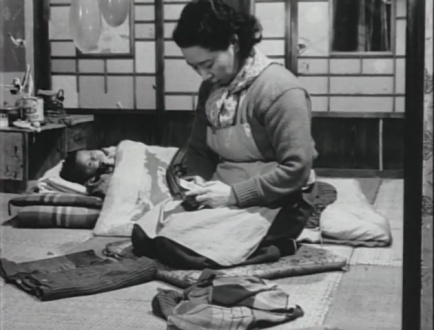
The baby left on the doorstep
Even a simple plot summary seems something of a mis-direction. Ken Uehara is a poor-but-honest shop clerk who lives with Kinuyo Tanaka in a small dilapidated house on the outskirts of Tokyo. He makes ends meet by renting an even more dilapidated house next door to a priest and the two upstairs rooms to shop girl Hideko Takamine and to Hiroshi Akutagawa, a student who pays his way through school by working as a tax collector. A baby is suddenly left in the house, throwing everything into chaos. I can almost hear the readers’ groans, as all the clichés, both comic and sentimental, of such a story leap to mind. But Heinosuke Gosho, working with a superb script by Hideo Oguni, who co-wrote almost all of Kurosawa’s great movies, itself adapted from a novel by Rinzo Shiina, who provided Gosho with three movies in 1953-54, skips over the sentimentality and instead gives us a detailed portrayal of postwar Japan that is also much more. Like Ikiru, another Oguni script, it gives you the impression of real life, not just its surface details but its human and humane core. A movie in which both funny things happen and terrible secrets are revealed, it seems to be really about life itself.
As I write that, it sounds awfully pretentious, but there is absolutely no pretentiousness about the movie itself. No one preaches, no one explains the true meaning of life. In fact, one of the points is that there is no one true meaning. The title refers to four prominent smokestacks for a large factory in the distance. They are arranged in such a way that, depending on where you stand, there are four, three, two, or even sometimes one. The movie is a working out of that symbolism in human terms, so that we gradually come to understand that what we see as the misdeeds of any character, for want of a better term, depends completely on where you are standing in relation to their own life, not yours.
The emotional core of the movie is Kinuyo Tanaka, 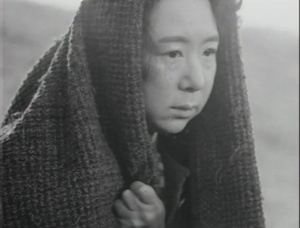 around whom the movie develops despite the opening narration by Uehara. She lost her family and, she thinks, her husband in the bombings of Tokyo. Eventually, she meets and marries Uehara and they both seem very happy, but he realizes that he knows absolutely nothing of her life before they met. Her monologue in which she describes coming home after the bombing and turning over the corpses to try to identify who actually died fully justifies her decision from that point on to depend on no one else, even setting up a new family register for herself alone. How she actually survived in the Occupation years is not detailed, but it is painful to watch her face as she tells this story. The moment is so real that you forget you are watching a great actress doing a great monologue.
around whom the movie develops despite the opening narration by Uehara. She lost her family and, she thinks, her husband in the bombings of Tokyo. Eventually, she meets and marries Uehara and they both seem very happy, but he realizes that he knows absolutely nothing of her life before they met. Her monologue in which she describes coming home after the bombing and turning over the corpses to try to identify who actually died fully justifies her decision from that point on to depend on no one else, even setting up a new family register for herself alone. How she actually survived in the Occupation years is not detailed, but it is painful to watch her face as she tells this story. The moment is so real that you forget you are watching a great actress doing a great monologue.
The baby is actually left by her old husband, who did not die, and he has registered the baby as Tanaka’s because the actual mother claims she doesn’t want it. This leaves Uehara in a bind. He is terrified of taking the baby to the police for fear he will be charged with bigamy, but he certainly does not want the child, not only because it isn’t his but also because of the expense. He is the quintessential average man. As he says, he will always do the right thing, if someone will just tell him what the right thing is. But in real life, there is no one to tell you but yourself. This makes him say some of the stupidest things you can imagine, for example charging her with the deceit of being secretly pregnant though he saw her and slept with her every evening for the last two years (the baby is a baby, only a few months old at best). Even when his wife tries to commit suicide, he is so confused that Akutagawa has to be the one to go drag her out of the river.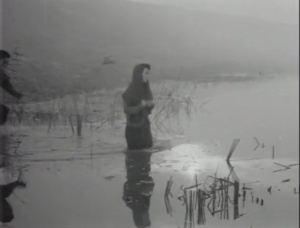
Takamine, though much younger, has her emotional baggage as well. She is hesitant to commit to any marriage or children because she lost her family in the war as well and carried her little brother on her back as she scrounged for food until he too died.
This suggests something heavy, and it is, for the problems are seen as genuine and real, not merely an excuse to hype up audience emotions. At the same time, the movie is often very funny. But the humor is unforced, based on observation of real life, not set up as jokes for comic relief. The movie has that strange ability to change mood constantly often found in other Japanese movies but not often seen in films from other countries. Yet it all seems of a piece, not like something thrown together.
Any hint of a quiet and serene Japan is long-gone here. They live in a world of noise, from the drums of the priest conducting chants and prayers to the constant radio. The other neighbors have seven kids. Takamine works reading ads out into the street from a loudspeaker all day long. Though there is a road by the houses rather than a railroad, the railroad can be heard in the distance, even as Takamine tries to walk into the river.** Everything anyone says or does is immediately heard by everyone else and private life is only a pretense.
Cultural details are so dense the movie could provide a research document about life in the early fifties. Just a few examples: the radio signs off at night with a reminder to everyone to put out the fire; Takamine lights her charcoal by setting it on an electric hot plate; whenever anyone turns out a light, they unscrew the bulb, even if there is also a switch; Tanaka and Uehara kiss so passionately that not only is Tanaka embarrassed when Takamine sees them through the open door but also Takamine comments that they can’t really be married if they act like that;
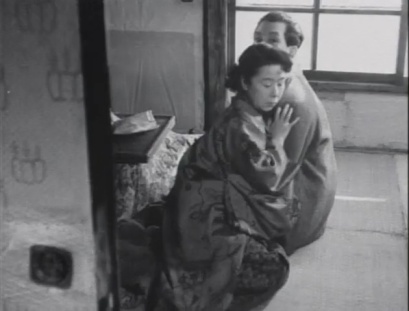
The embarrassed couple
to avoid having unwanted children, Uehara has a calendar with certain days of the month prominently marked, indicating some form of the rhythm method being practiced; Tanaka has a secret part-time job at the cycling track, apparently selling some kind of racing tips since she does not seem to actually be a bookie, which she signals to customers by a gigantic American farm style sun bonnet (by the way, the cycling stands are packed with crowds, far different from the almost empty baseball stadium in Green Tea Over Rice, made at about the same time). The complexities of the family register remain all but inexplicable; apparently there is no birth certificate from a doctor or midwife or the hospital, so the earlier husband can claim Tanaka actually was the mother. And of course, the confusions caused by the war and the fire-bombing that wiped out so many records make it possible for people to claim all kinds of things that aren’t quite true, and for Tanaka to re-marry quite legitimately on one register even though on another register she is still married.
Shoes provide a running visual theme, from Tanaka’s first appearance brushing her husband’s shoes for work that are desperately in need of new soles. Tanaka gets out her best pair of geta to wear when she decides to commit suicide, and Akutagawa when rescuing her has to come back to rescue one of his that has gotten stuck in the mud. Takamine has a friend who, after walking out on her mistress position, walks along with the baby’s real mother, who breaks the thong on her geta. The friend gives her one of her high heels and they limp along the road together, where they meet another woman on a crutch.
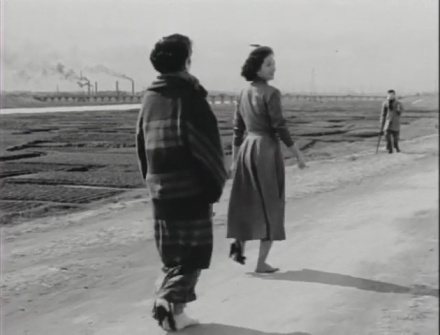
Sharing the pain, with the four chimneys in the distance
The movie’s detail is so dense I haven’t the space to even go into the oddly-developing romance between Akutagawa and Takamine, or to deal with the true story of the old husband when he is found, or of the baby’s real mother, or the friend who cheerfully opts for the life of a mistress and just as cheerfully opts out of it.
As the director, Gosho here is the man without a signature. Though there are numerous cuts, it lacks the repetitious choppiness of Ozu’s films of the time. Unlike Mizoguchi, he is not afraid of the close-up, and unlike Kurosawa, he does not drive the film forward with editing, energy, and sometimes pure will-power. Nor does he look like the Gosho who directed Inn at Osaka, where everything was quietly observed at a distance and through doorways, though it does express the same acceptance and understanding of its characters. The shots chosen and the cutting are simply the right ones. This is another of those symphonies from chamber music that the best Japanese movies of this period seemed to be and that I have commented on before. With only four main characters and three minor ones, we seem to have encompassed the world not in its endless variety but rather in its shared humanity. By paying close attention to the tiniest of worlds, that world becomes universal.
If nothing else, Where Chimneys Are Seen cements 1953 as the greatest single year in Japanese cinema, and in my opinion, the world’s as well.
It is on YouTube, so you can find it now without effort. But watch it on a big screen TV, not a computer, so you can immerse yourself in it without distractions.
- * Number four on the Kinema Junpo list for 1953, behind Nigorie, Tokyo Story, and Ugetsu, it also won Gosho the Best Director at the Berlin Film Festival that year. However, like Sansho the Bailiff, whose deeply expressed humanity it resembles, it does not seem to be on either the 1999 or the 2009 Kinema Junpo top 100 lists.
- ** I think this may be the same river and railroad bridge whose sound interrupted the very serious declaration of love in Shimazu’s Our Neighbor, Miss Yae, with the scene once again shot on location with live sound.
Pingback: Intentions of Murder (1964) | Japanonfilm
Pingback: Hunting Rifle / Ryoju (1961) | Japanonfilm
Pingback: The Only Son / Hitori musuko (1937) | Japanonfilm
Pingback: Setsuko Hara | Japanonfilm
Pingback: Rebellion of Japan / The Banquet / Utage (1967) | Japanonfilm
Pingback: Castle of Sand / Suna no utsuwa (1974) | Japanonfilm
Pingback: Night of the Felines / Mesunekotachi no yoru (1972) | Japanonfilm
Pingback: Preparation for the Festival / Matsuri no junbi (1975) | Japanonfilm
Pingback: Diary of a Bride / Hanayome Nikki (1934) | Japanonfilm
Pingback: Memories of You / Kaisha monogatari: Memories of You (1988) | Japanonfilm
Pingback: Grave of the Fireflies / Hotaru no haka (1988) | Japanonfilm
Pingback: Nowhere Man / Muno no hito (1991) | Japanonfilm
Tremendous review of an amazing film. As you say, this is a masterpiece that you just don’t hear about in other conversations about the great films of this era. But it’s right there with them. In many ways, it feels like an Ozu film, but with a free-roaming camera. I was super-impressed by the first 10 minutes, with the camerawork and what seemed to be an approach that was going to involve meta-narration. That kind of went by the wayside — we, of course, weren’t going to have a Charlie Kaufman film from 1950s Japan — but what it moved into was something even better, as you note throughout your review. This is one of the most natural dramas I’ve seen from any country. Little of it feels forced, cinematic or scripted. Now I need to track down more Gosho films. I have The Inn at Osaka but have yet to watch it. I’d really like to track down Northern Elegy, based on what I’ve read about it. Also, it sounds like this may be the most naturally funny & optimistic of Gosho’s post-war films, which is a shame, because everyone nails that tone here.
LikeLike
I too would like to find a copy of Northern Elegy. If you succeed, let me know.
LikeLike
Pingback: Half Brothers / Stepbrothers / Ibo kyoudai (1957) | Japanonfilm
Pingback: One Thousandth Post | Japanonfilm